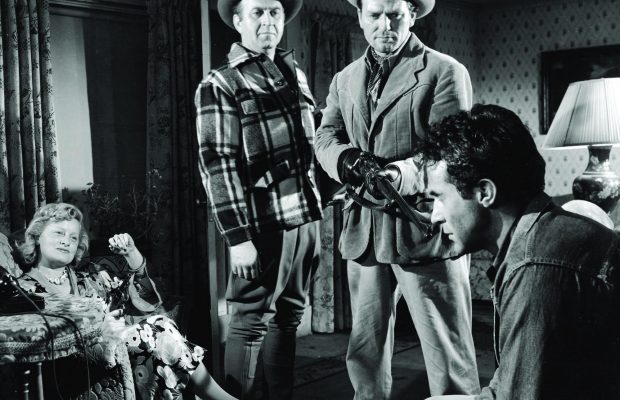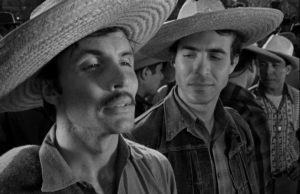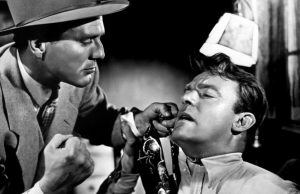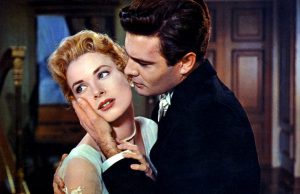Border Incident (1949)

 |
Run Time: 92 min. | b/w
Director: Anthony Mann Stars: Ricardo Montalban, George Murphy, Howard Da Silva, Charles McGraw Genres: Drama | Film-noir |
| Storyline Montalban effectively plays an immigration agent used as a decoy to break up a large “slave trading” market run through the Texas/Mexico border. A tension-packed story of victimization and murder, unfortunately still topical. |
|










Here is some spectacular film noir photography by the same team (Director Anthony Mann and cinematographer John Alton) that brought you He Walked By Night, Ray Deal and T-Man. The photography is as good as anything in those movies, if not better. This is good stuff; great direction, with interesting closeups, wide-angle lenses, low-angle shots, tons of shadows and light. Instead of a big city, we had the desert as the main area. The DVD transfer is terrific, too.
All of this, to me, was more fun to watch than the actual story, although the second half of this movie is extremely tense and well done. It makes up for the first half which is a bit on the sordid side at times and a bit slow at times, but definitely film noir material meaning a feeling of dread just around each corner. The suspense gets really thick in the last 20 minutes when George Murphy is discovered by th sadistic criminals to be an undercover lawman. What happens to Murphy is memorable.
Howard da Silva and Charles MacGraw are effective as the main villains. MacGraw's distinctive voice alone makes him a film noir Hall of Famer. Murphy – known more for his light-hearted hoofer films – does a credible in here and it was interesting to see Ricardo Montalban (of TV's "Love Boat" fame) as such a young man. Those two play the good guys.
This is a tough, all-male cast with no romances or soft stuff. In a way, the atmosphere reminded me a bit of another tough noir, "The Big Combo," although the subject matter here is entirely different than any other noir I know about: immigrants crossing the border. However, unlike the real-life situation that is a major story today, this involves Mexicans crossing the border to do migrant farm work, and then getting robbed and killed by bandits on the way home. Still, the subject of "illegals" is a big part of this story and ironic to watch today in light of what's happening now.
Anyway, if you enjoy literally-dark stories, and am a fan of film noir, check this movie out.
First off, that look! This is a major John Alton achievement, one of the most atmospheric noirs: brooding overcast Mexican skies dominate many scenes, and several others are shrouded in threatening obscurity. All to the effect of heightening the drama of this taut film. Occasionally, it recalls the dark Mexican ambience of "Ride The Pink Horse", another great South-of-the-border Film Noir.
As for drama, this is an action-packed noir from beginning to end (once past the stentorian narrator we all love to hate–though he keeps it brief). Terrific chase scenes and fights, all done with conviction. The quicksand episodes are downright disturbing.
The cast–where to begin? Ricardo Montalban is just plain great in this one, conveying all the humanity and determination his character requires. And George Murphy does just fine as his counterpart. Some favorite noir villains are on hand and in fine form: Howard Da Silva–subtle and smouldering, Charles McGraw–intimidating and scary.
James Mitchell–a fine, lithe performer. He and Montalban make a great pair. Is it my imagination that there is a very slight touch of homoeroticism between them? Montalban (Pablo Rodriguez), a looker himself, attaches to the handsome Mitchell (Juan Garcia) and in no time they are calling each other "Pablito" and "Juanito" (terms of endearment, no?). Alton and Mann shoot them in tight, intimate closeups at several points. Mitchell’s last line is memorable "Now one knows the meaning of the ‘soft hands’", referring to the lack of ‘bracero’ calluses on Montalban’s palms.
The horrors of illegal immigration from Mexico have not gone away 50+ years later, they are depicted in this film with honesty and humanity.
Border Incident starts off in the typical 'Your Government Working For You' fashion that makes so many noirs start at a crawl before finally getting into the story. The dialogue feels like it hasn't just been approved by every law enforcement body in America and Mexico but written by them as well. At first it looks like Anthony Mann's strong directorial style will never surface through the MGM production line sheen, but having got the advertorial exposition out of the way he seems to gradually wrest control away from the suits the further away he gets from them on location until it's definitely a Mannly film, and one that offers a direct point of transition between his noirs and his dark psychological westerns. By the time its ill-starred characters have moved from a secure world of visual order and perfectly composed balance and traversed a hostile landscape as desolate as the people-smugglers' morality to end up in one of Mann's beloved mountain/canyon shootouts, there's no doubt who is calling the shots.
Mann's trademark violence is also very much in evidence, with the film offering one truly strikingly unpleasant death for 1949 – when shooting and being brutally rifle-butted in the head doesn't finish off the victim, something even more searingly violent does the trick: dust to dust indeed. But that's very much in keeping with the characters' brutally disinterested attitude to death. People aren't just killed, they're literally swallowed by a callous and impersonal land that leaves no trace of their ever having existed. Once there's no more profit to be made from the illegals or their own cohorts, they simply disappear forever. Mann had no equal in using the landscape to define character, but here the landscape itself is not just a character but an accomplice.
A big part of the credit belongs to cinematographer John Alton, who Mann apparently insisted on taking with him when he moved from Eagle-Lion to a contract with Leo. His deep blacks, his great sense of changing perspective (an important visual motif in all of Mann's films), his intelligent use of long lenses to expand the moral and physical distance between protagonists, and one remarkable night sequence where a truck leaves an almost luminous trail of dust in its wake help elevate what could have just been a production-line procedural into something much more primal and substantial. It's not just a matter of making striking images – the director and cinematographer's complimentary visual imaginations don't simply serve the story but also establish these characters' place in the world and their shifting relationships as power and loyalty become increasingly fluid commodities.
Ricardo Montalban and George Murphy may seem unlikely leads, but they work better than expected, and there's a great cast of character players to back them up – Alfonso Bedoya, Arnold Ross (so memorable in Mann's Reign of Terror/The Black Book), Charles MacGraw, Arthur Hunnicutt and the great Sig Rumann. Quietly towering over them all is Howard Da Silva's confident and almost casual ringleader, a man who finds that control is illusory. Despite having the best (but still unshowy) dialogue, the temptations to become a stereotype are avoided in favor of a much more interesting and rounded creation – he doesn't need to act menacing because he has people to do that for him.
Like most of Mann's noirs (with the exception of the period thriller Reign of Terror/The Black Book), it's not one of the great Mann films – but it ends up a damn good one. I kinda liked it…
Warners' Region 1 DVD boasts a good transfer and an excellent commentary by Dana Polan and the original theatrical trailer.
An underrated gem from the cannon of Anthony Mann. Two agents – one American, one Mexican – cooperate on an investigation into illegal immigrant farm labour. The bad guys are the people smugglers, and boy are they bad – evil, ruthless and sadistic. Contains scenes of extreme violence which Hollywood tolerated in certain westerns and noirs of the late 40’s post-war era, and this is kind of a western noir crime movie with lots of vegetables. Its a movie that could give you nightmares, especially if you approach it unaware due to its age, that its actually quite disturbingly brutal and relentless.
Easily ranks as Ricardo Montoblan’s finest performance, and only makes one baffled as to how he became such a shameless ham later in life with the likes of Fantasy Island. George Murphy, who plays the American agent, had a fascinating career. Dropping out of Yale to become a coal stoker, he switched to a tap dancing hoofer in 30’s pictures, then a solid supporting actor in war pictures. Following the lead of his pal Ronnie Reagan he entered Republican politics, rising to become a member of the US Senate for California.
John Alton lensed this picture, and his monochrome work is a remarkably beautiful achievement. Only a year after this movie Alton would photograph An American In Paris – easily one the best Technicolor movies ever shot.